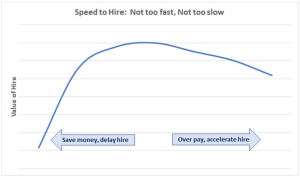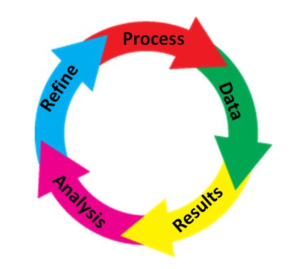Editor’s note: This article is part of a series highlighting speakers at the upcoming ERE Digital event. Click here to view other articles in the series.
What if your recruiting function could turn your company into what McKinsey calls a “grower”? Or if recruiting could be the key to making your company cash flow positive? We estimate that the hidden value in recruiting that can be unlocked by data and analytics can add the equivalent of 4% to 5% of revenue — over $4 million for a $100 million revenue company — every year.
Capturing this value doesn’t require that the recruiting team (already under pressure) work harder or learn data science. It does mean that recruiting leaders have to think of recruiting as a business. At its heart, recruiting takes raw inputs (candidates), transforms them through the interview and assessment process, and delivers refined outputs (new hires!), meeting a grateful customer’s (i.e., hiring manager’s) business needs.
At the upcoming ERE Digital event (April 15–17), we’ll be talking about how analytics can help you work smarter with your limited resources. You don’t have to be a data analyst to “Run a Lean, Mean Recruiting Machine.” We’ll show you how to team up with the data experts in your company to help you:
- Understand what volume you need at every stage of your funnel to meet your hiring goals
- Calibrate speed through funnel — understand the cost of moving too slowly, and know when you’re going too fast
- Show your leaders how to balance aggressive hiring goals, speed of hiring, and quality of hires
The recruiting business model generates lots of data — page views, click-throughs, apply starts, interview assessment ratings, offer parameters, acceptance and decline rates, and more. And sure enough, businesses are learning how to apply state-of-the-art analytics to become more efficient, more effective, and make better decisions as they discover hidden value in recruiting.
And they’re often finding that value in the shadowy corners of inefficient processes and inaccurate decisions. Inefficient processes result in delays, like taking too long to fill a position, or worse, not filling it at all. Every day that engineer seat is empty, or that salesperson isn’t closing a deal, means forfeited revenues. Poor decisions mean hiring the wrong person — or failing to hire the right person. Poor decisions also result in revenues delayed, or forever lost. Poor decisions destroy value.
3 Examples of Unlocking Hidden Value
1. Understanding How Uncertainty Creates Unforeseen Delays and Obstacles
Kim is responsible for helping her company meet aggressive growth goals by recruiting and hiring five engineers a week for 10 weeks, 50 in all. Kim is certain she can deliver based on recent hiring success:

Things don’t go as planned. Almost immediately, Kim misses her weekly goal. What’s happening?
It turns out that an average of 100 applicants or 40 interviews a week isn’t the same as exactly 100 applicants or 40 interviews. Weeks with higher than average results, or below average results, wreak havoc with the business outcomes.
Fortunately, Kim has made friends with Alex in the analytics group. Alex shows her, using a fancy technique called Monte Carlo simulation and an easy-to-grasp dashboard, that her chances of success over ten weeks are not 100%, not even 50%, but less than 1%. Before Kim panics, Alex also shows her some quick steps that raise her odds of success to over 80%. We’re looking forward to diving deeper into this example during our presentation to show you the insights that save the day for Alex.
2. How to Think About Speed in Recruiting
We’ve mentioned that speed-to-hire is a critical variable for the value of the recruiting business. A 30-day hiring delay for critical talent holds back the revenue-generating activities of that talent by 30 days, which adds up to big bucks over time. So it should make sense to do everything it takes to hire quickly, even if it means paying above market, right?
Not so fast! We can apply the techniques of financial optimization to determine the “sweet spot” for hiring speed.

The shape of the curve implies that using compensation to speed up hiring, or conversely slowing hiring to save money, destroys value in both directions. This is an important concept for recruiters — and hiring managers — to understand and agree on.
3. Getting It Right: The End-to-End Assessment
How do you know if your recruiting function is effective? How can you be sure you are putting the right people in the right seats at the right time at the right cost? You need an end-to-end assessment process that measures and models every critical step of the recruiting funnel and continues through onboarding and assimilation phases (typically the first three to six months after the hire date).
The end-to-end assessment measures effectiveness and shows where to focus your efforts to continuously improve via test-and-learn.

Ultimately, there are systematic ways to use data and analytics to unlock hidden value in recruiting and elevate your recruiting function. And when you do so, you’ll be seen as a business leader with that seat at the table.
Interested in learning more from Matthew and Raj about how you can elevate your recruiting function? Experience their session at ERE Digital, April 15 – 17. Use code ERESD10EXTRA to receive 10% off your ticket price.
